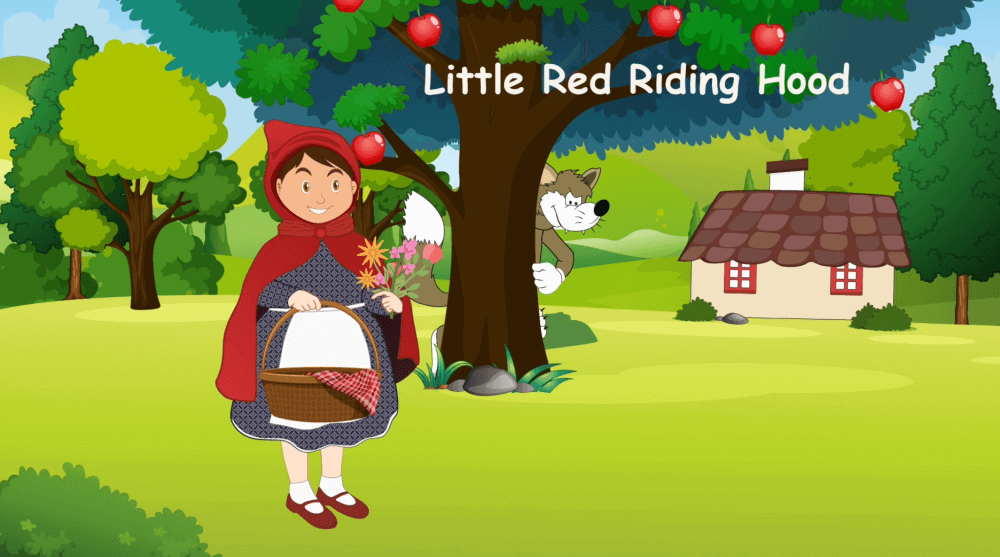Our aim is to give you a concise but rich and detailed summary that captures why this story endures, how different editions affect its meaning, and what lessons it still teaches today.
Plot Summary
Early Setup
A girl known as little red riding hood (or Little Red Cap) is sent by her mother through the woods to her ailing grandmother, carrying a basket with food and accompanied by instructions: stay on the path, don’t speak to strangers. She wears a red cloak or cap, given by her grandmother, which gives her the nickname. (Perrault version)
Encounter with the Wolf
On her way, she meets a cunning wolf. In many versions, she reveals her destination. The wolf tricks her: while she wanders (often distracted by flowers or beauty), he takes a shortcut to the grandmother’s house.
Wolf at Grandmother’s House
The wolf arrives first. Depending on the version, he either eats the grandmother (Perrault, some Grimm versions) or locks her away. Then the wolf disguises himself in grandmother’s clothing, takes her place in bed, hoping to deceive Little Red Riding Hood.
Red Riding Hood Arrives & the Deception
When Little Red Riding Hood gets to the cottage, she notices odd things: “Grandmother, what big ears you have,” “What big eyes,” “What big teeth,” etc. The wolf uses these to maintain the disguise until the final moment.
Climax and Ending
- In Perrault’s original telling: the wolf eats both grandmother and Little Red Riding Hood, and there is no rescue. The tale ends with a moral warning.
- In the Brothers Grimm version and many later adaptations: a hunter or woodsman arrives in time, frees grandmother and child by cutting open the wolf’s belly. The wolf is often punished (stones in his stomach, etc.), and Red Riding Hood learns her lesson about obeying her mother and avoiding strangers.
Versions & Variations
- Charles Perrault (1697): More moralistic; the heroine does not survive in many versions. The story ends with explicit warnings about talking to strangers and trusting appearances.
- Brothers Grimm (1812): Adds a rescuer; happier ending; more detail about Red Riding Hood’s character (her disobedience, her journey through the woods).
- Modern retellings: Some soften violence; some change the role of the wolf; some turn the story into one of empowerment; others emphasize psychological and symbolic meanings.
Characters
- Little Red Riding Hood (Red Cap): Innocent, naive, but curious. Her red hood symbolizes childhood, innocence, sometimes danger or warning.
- Mother / Parent Figure: Gives instructions; often warns Red about staying on the path and not talking to strangers.
- Grandmother: Vulnerable; represents older generation. In some versions, helpless; in others, takes part in defeat of the wolf.
- Wolf: Deception, danger, predation. Sometimes anthropomorphized, uses cunning; represents both physical and moral threats.
- Rescuer (Hunter/Woodsman): Not present in all versions; appears in Grimm’s versions; acts as agent of safety and justice.

Themes & Symbolism
- Obedience vs. Disobedience: Red’s ignoring instructions leads to danger. The lesson often stresses the importance of following wise counsel.
- Danger of Naivety / Trusting Strangers: The wolf’s ability to deceive depends on Red’s openness and innocent trust.
- Appearance vs. Reality: Grandmother’s house, the wolf dressed in grandmother’s clothes, Red being fooled by outward signs.
- Transition & Growing Up: The journey through the woods is symbolic of risk, exploration, and learning.
- Morality & Punishment: In many versions, the wolf is punished; moral lessons are highlighted explicitly, especially in earlier versions.
Discover Creativity and Learning with Educational Toys for Kids Aged 4 to 10
Historical & Cultural Context
- The tale appears in oral tradition across Europe long before it was written down.
- Perrault’s version is among the earliest published versions; intended in part as warning literature with a clear moral lesson.
- The Grimm Brothers’ version is more elaborate and reflects 19th-century values of family, responsibility, social order.
- Across time, adaptations reflect changing attitudes about childhood, danger, gender roles, and what kinds of endings audiences expect.
Significance in Literature & Lessons for Today
- Teaches critical thinking: speaking to strangers, being cautious, discerning appearances.
- Influences countless other stories, adaptations, modern media. Uses of wolves, red cloak, grandmother figure have become archetypes.
- Offers insight into human psychology: fear, deception, protection, community.
Conclusion
“Little Red Riding Hood” remains a timeless fairy tale because it weaves together simple narrative, vivid symbolism, and clear moral stakes. While its core story—a young girl sent to her grandmother, seduced by danger, confronted with deception—is brief, its variations across time deepen its power. We see striking differences between Perrault’s darker version and the Grimm Brothers’ version with rescue and punishment, but both serve to warn, teach, and reflect cultural values about innocence, danger, and obedience. The characters—Little Red Riding Hood, the wolf, the grandmother, the rescuer—become symbols we understand intuitively.
Whether the ending is tragic or hopeful, the lessons endure: be cautious, follow wise guidance, recognize that appearances can deceive. This tale’s capacity to adapt, resonate with shifting cultures, and still frighten or comfort makes it one of the great classic stories.
People Also Ask
- What is the moral of Little Red Riding Hood?
The moral is typically about the danger of trusting strangers, the importance of obeying parental or wise counsel, and being cautious of appearances. Different versions emphasize different aspects, like innocence lost or responsibility. - How do the Perrault and Grimm versions differ in Little Red Riding Hood?
Perrault’s version is darker and ends without rescue; Grimm adds a woodsman/hunter who saves Red and her grandmother. Also, Grimm includes more dialog, more detail, and tends to highlight punishment for the wolf. - Why is the red hood important in the story?
The red hood or cape symbolizes innocence, youth, even danger or warning. It makes Red obvious and vulnerable, and makes the story visually memorable. In some interpretations it also signals transition or coming of age. - What does the wolf represent in Little Red Riding Hood?
The wolf often represents temptation, danger, deception. It can symbolize external threats like predators or untrustworthy people, and internal threats like naivety or curiosity. - Why has Little Red Riding Hood remained popular over time?
Because it touches on universal fears and lessons—trust, danger, innocence, deception. It is adaptable, with versions for children, adults, with varying moral shades. Its archetypal characters and vivid imagery make it memorable and easy to retell.


